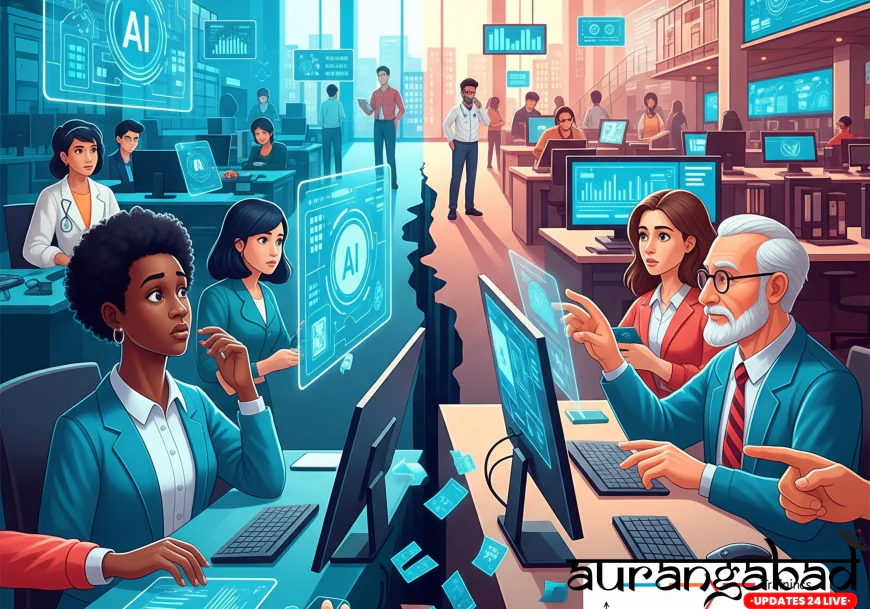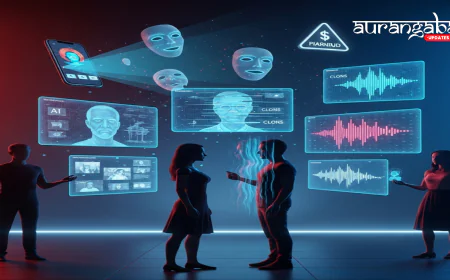US Workplaces Embrace AI, But Half the Workforce Lacks Training: Bridging the Skills Gap
While AI is integrated into 93% of US workplaces, a Forbes survey reveals only 49% of employees are trained to use it. This significant skills gap risks hindering productivity, warns experts, urging urgent investment in workforce reskilling.

NEW YORK: Artificial intelligence (AI) is no longer a futuristic concept confined to research labs; it has become an undeniable force rapidly reshaping the American workplace. A staggering 93% of U.S. businesses are now adopting AI technologies across a diverse array of sectors, from retail and finance to healthcare and logistics. This pervasive integration signals a new era of productivity and innovation. However, a recent Forbes survey reveals an alarming disconnect: barely half—a mere 49%—of the U.S. workforce is adequately trained to utilize these transformative AI tools. This substantial skills gap poses a critical risk, threatening to undermine AI's potential benefits and leaving a significant portion of the workforce unprepared for the future of work.
The rapid embrace of AI by American companies underscores a clear strategic imperative: to leverage cutting-edge technology for competitive advantage. Businesses are not just experimenting with AI; they are investing heavily, with 93% planning to escalate their AI investments over the next two years, and over half earmarking budgets that will surge by more than 16%. This financial commitment reflects a deep-seated belief in AI's capacity to streamline operations, enhance decision-making, and unlock new opportunities for growth. Yet, amidst this frenetic pace of adoption and investment, employee training is consistently failing to keep pace.
The Alarming Disparity: Investment vs. Preparedness
The dichotomy between AI adoption rates and workforce training levels is stark and concerning. While companies are pouring billions into acquiring and deploying AI solutions, the human element—the very employees tasked with operating and interpreting these systems—are being left behind. The Forbes survey's finding that only 49% of employees are trained to use AI tools highlights a fundamental oversight in many corporate AI strategies.
This significant training deficit manifests in several critical ways:
-
Underutilized Potential: AI tools, however sophisticated, remain underutilized if employees lack the knowledge or confidence to apply them effectively. This translates into missed opportunities for productivity gains and a suboptimal return on substantial AI investments.
-
Operational Inefficiencies: An untrained workforce can lead to inefficient processes, as employees struggle to integrate AI tools into their daily workflows, or even resort to manual methods due to a lack of understanding.
-
Failed Implementations: In some cases, the absence of comprehensive training can lead to outright failed AI implementations, as employee resistance, errors, or a fundamental misunderstanding of the technology prevent successful deployment.
-
Lack of Confidence: Employees who are not properly trained often feel overwhelmed and insecure when confronted with new AI technologies. This can lead to anxiety, resistance to adoption, and a reluctance to experiment with new tools.
Who's Lagging Behind and Why: Unpacking the Reasons for the Gap
The question of "who is falling behind and why" is multifaceted. While the specific demographics most affected may vary, several common reasons contribute to this training disparity:
-
The Rush to Implement: Many organizations are caught in a "race to adopt" AI, driven by competitive pressures to stay ahead of rivals. In this rush, the crucial step of comprehensive employee training is often deprioritized or viewed as an afterthought. Companies focus on acquiring the technology first, assuming employees will catch up.
-
Mistaken Assumptions about Digital Fluency: There's a prevalent, yet flawed, assumption that younger employees or those deemed "digitally fluent" will inherently adapt to AI tools on their own, requiring minimal formal training. However, AI literacy extends far beyond basic digital familiarity; it requires an understanding of algorithms, critical interpretation of AI outputs, and knowing when human intervention is necessary.
-
Insufficient Investment in Reskilling: Despite increasing AI budgets, the proportion allocated specifically to workforce reskilling and upskilling for AI integration may be inadequate. Companies might invest heavily in software and infrastructure but neglect the human capital development necessary to leverage those investments.
-
Lack of Accessible and Relevant Training Programs: The availability of training programs that are easily accessible, tailored to specific job roles, and effectively communicate complex AI concepts in a digestible manner may be limited. Employees often need more than just a quick tutorial; they need structured learning paths that build foundational AI knowledge.
-
Resistance to Change: Without proper communication and training, employees may perceive AI as a threat to their jobs rather than a tool to enhance their capabilities, leading to resistance to adoption.
Bridging the Gap: Solutions and Strategies for a Future-Ready Workforce
Addressing the widening AI skills gap is an urgent imperative for U.S. workplaces to fully realize the benefits of their AI investments and ensure workforce stability. A multi-pronged approach is necessary:
-
Prioritizing Comprehensive Training: CHROs (Chief Human Resources Officers) and corporate leadership must make AI and data analysis training a top priority, aligning it directly with AI implementation strategies. Training should be structured, ongoing, and tailored to specific departmental and role-based needs.
-
Developing AI Literacy Programs: Training should focus on fostering genuine AI literacy, which includes understanding how AI works (even at a conceptual level), how to effectively interact with AI models (prompt engineering), how to critically evaluate AI-generated outputs, and how to identify ethical considerations or biases.
-
Investing in Reskilling and Upskilling: Companies should proactively invest in robust reskilling programs for existing employees, particularly those whose roles may be augmented or transformed by AI. Upskilling initiatives can equip employees with advanced AI skills, enabling them to take on new, higher-value roles.
-
Government Initiatives and Academic Reforms: Government bodies can play a role in funding AI training programs, establishing industry-recognized certifications, and incentivizing companies to invest in workforce development. Academic institutions need to rapidly integrate AI literacy and application into diverse curricula, not just computer science degrees.
-
Fostering a Culture of Lifelong Learning: Organizations must cultivate a culture that embraces continuous learning and adaptation. Employees should be encouraged and supported in developing new skills as technology evolves.
-
Experiential Learning: Providing hands-on opportunities to work with AI tools through pilot projects, hackathons, or internal innovation challenges can build confidence and practical expertise.












































